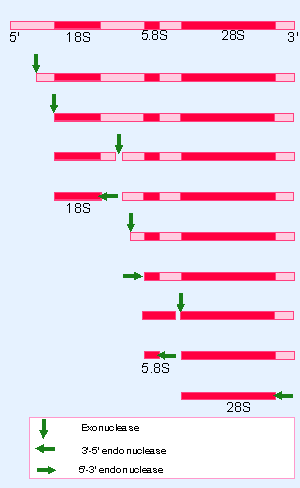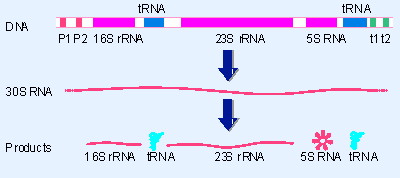13. Small RNAs are required for rRNA processing
22.12 Production of rRNA requires cleavage and modification events |
The major rRNAs are synthesized as part of a single primary transcript that is processed to generate the mature products. The precursor contains the sequences of the 18S, 5.8S, and 28S rRNAs. In higher eukaryotes, the precursor is named for its sedimentation rate as 45S RNA. In lower eukaryotes, it is smaller (35S in yeast).
 |
Figure 22.33 Mature rRNAs are generated by cleavage and trimming events from a primary transcript |
The mature rRNAs are released from the precursor by a combination of cleavage events and trimming reactions (for review see Venema and Tollervy, 1999). Figure 22.33 shows the general pathway in yeast. There can be variations in the order of events, but basically similar reactions are involved in all eukaryotes. Most of the 5′ ends are generated directly by a cleavage event. Most of the 3′ ends are generated by cleavage followed by a 3′-5′trimming reaction.
Many ribonucleases have been implicated in processing rRNA, including the exosome, an assembly of several exonucleases that also participates in mRNA degradation (see 5.9 Yeast mRNA degradation involves multiple activities). Mutations in individual enzymes usually do not prevent processing, suggesting that their activities are redundant and that different combinations of cleavages can be used to generate the mature molecules.
There are always multiple copies of the transcription unit for the rRNAs. The copies are organized as tandem repeats (see The repeated genes for rRNA maintain constant sequence).
5S RNA is transcribed from separate genes by RNA polymerase III. Usually the 5S genes are clustered, but are separate from the genes for the major rRNAs. (In the case of yeast, a 5S gene is associated with each major transcription unit, but is transcribed independently.)
 |
Figure 22.34 The rrn operons contain genes for both rRNA and tRNA. The exact lengths of the transcripts depend on which promoters (P) and terminators (t) are used. Each RNA product must be released from the transcript by cuts on either side. |
There is a difference in the organization of the precursor in bacteria. The sequence corresponding to 5.8S rRNA forms the 5′end of the large (23S) rRNA, that is, there is no processing between these sequences. Figure 22.34 shows that the precursor also contains the 5S rRNA and one or two tRNAs. In E. coli, the 7 rrn operons are dispersed around the genome; four rrn loci contain one tRNA gene between the 16S and 23S rRNA sequences, and the other rrn loci contain two tRNA genes in this region. Additional tRNA genes may or may not be present between the 5S sequence and the 3′ end. So the processing reactions required to release the products depend on the content of the particular rrn locus.
In both prokaryotic and eukaryotic rRNA processing, ribosomal proteins (and possibly also other proteins) bind to the precursor, so that the substrate for processing is not the free RNA but is a ribonucleoprotein complex.
| Reviews | |
| Venema, J. and Tollervey, D. (1999). Ribosome synthesis in S. cerevisiae.. Ann. Rev. Genet. 33, 261-311. | |